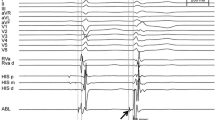Abstract
The involvement of the Purkinje system in a subset of patients with idiopathic ventricular fibrillation or polymorphic VT/VF related to structural heart disease was first demonstrated in the pioneering work of Michel Haissaguerre and co-workers (Circulation 106:962–967, 2002 and Lancet 359:677–678, 2002). It is very important to identify these patients with recurrent episodes of ventricular fibrillation and/or ICD shocks with regard to the presence of triggering premature ventricular contractions (PVC), which may be amenable to mapping and catheter ablation by screening Holter and ICD recordings. The practical problem, which is frequently encountered, is the absence of these PVCs when the patients are brought to the EP lab. However, catheter ablation is an important adjunctive tool to antiarrhythmic drug treatment, beta blocker therapy, and general anesthesia in this setting. Local electrogram criteria related to this phenomenon have been identified guiding mapping and ablation (e.g., low amplitude, high-frequency Purkinje potentials preceding a closely coupled ventricular signal (Fig. 1a)). The favorable long-term follow-up after catheter ablation has been demonstrated in the setting of right and left ventricular Purkinje-related PVCs leading to polymorphic VT/VF (Leenhardt et al., Circulation 89:206–215, 1994) and also following myocardial infarction (Baensch et al., Circulation 108:3011–3016, 2003) and right ventricular outflow tract-associated VF (Noda et al., Journal of the American College of Cardiology 46:1288–1294, 2005). Most recently, epicardial ablation strategies leading to suppression of polymorphic VT/VF episodes related to the Brugada syndrome have been described irrespective to the presence of premature ventricular beats (Nademanee et al., Circulation 123:1270–1279, 2011).




Similar content being viewed by others
References
Aliot, E., Stevenson, W., Almendral-Garrote, J., Bogun, F., Calkins, C., Delacretaz, E., et al. (2009). EHRA/HRS expert consensus on catheter ablation of ventricular arrhythmias. Heart Rhythm, 6(6), 887–933.
Baensch, D., Oyang, F., Antz, M., Arentz, T., Weber, R., Val-Mejias, J., et al. (2003). Successful catheter ablation of electrical storm after myocardial infarction. Circulation, 108, 3011–3016.
Haissaguerre, M., Shoda, M., Jais, P., Nogami, A., Shah, D., Kautzner, J., et al. (2002). Mapping and ablation of idiopathic ventricular fibrillation. Circulation, 106, 962–967.
Haissaguerre, M., Shad, D., Jais, P., Shoda, M., Kautzner, J., Arentz, T., et al. (2002). Role of Purkinje conductioning system in triggering of idiopathic ventricular fibrillation. Lancet, 359, 677–678.
Dessertenne, F. (1966). La tachycardia ventriculaire à deux foyers opposes variables. Arch Mal Cœur, 59, 263–272.
Belhassen, B., Pelleg, A., Miller, H., & Laniado, S. (1981). Serial electrophysiological studies in a young patient with recurrent ventricular fibrillation. PACE, 4, 92–99.
Leenhardt, A., Glaser, E., Burguera, M., Nürnberg, M., Maison-Blanche, P., & Coumel, P. (1994). Short-coupled variant of Torsade de Pointes. A new electrocardiographic entity in the spectrum of idiopathic ventricular tachyarrhythmias. Circulation, 89, 206–215.
Dosdall, D. L., Cheng, K. A., Huang, J., Allison, J. S., Allred, J. D., Smith, W., et al. (2007). Transmural and endocardial Purkinje activation in pigs before local myocardial activation after defibrillation shocks. Heart Rhythm, 4(6), 758–765.
Dosdall, D. L., Tabereaux, P. B., Kim, J. J., Walcott, G. P., Rogers, J. M., Killingsworth, C. R., et al. (2008). Chemical ablation of the Purkinje system causes early termination and activation rate slowing of long-duration ventricular fibrillation in dogs. American Journal of Physiology - Heart and Circulatory Physiology, 295(2), 883–889.
Li, L., Jin, Q., Huang, J., Chang, K. A., & Ideker, R. E. (2008). Intramural foci during long duration fibrillation in the pig ventricle. Circulation Research, 102(10), 1256–1264.
Napolitano, C., Bloise, R., Monteforte, N., & Priori, S. (2012). Sudden cardiac death and genetic ion channelopathies: long QT, Brugada, short QT, catecholaminergic polymorphic ventricular tachycardia, and idiopathic ventricular fibrillation. Circulation, 125, 2027–2034.
Kass, R. S., & Moss, A. J. (2003). Long QT syndrome: novel insights into the mechanisms of cardiac arrhythmias. Journal of Clinical Investigation, 112(6), 810–814.
Brugada, P., Zipes, P. D., & Jalife, J. (Eds.). (2000). Cardiac electrophysiology: From cell to bedside (p. 633). Philadelphia: Saunders.
Ventura, R., Steven, D., Klemm, H., Lutomsky, B., Müllerleile, K., Rostock, T., et al. (2007). Decennial follow-up in patients with recurrent tachycardia originating from the right ventricular outflow tract: electrophysiologic characteristics and response to treatment. European Heart Journal, 28, 2338–2345.
Nademanee, K., Veerakul, G., Chandanamattha, P., Chaothawee, L., Ariyachaipanich, A., Jirasirirojanakorn, K., et al. (2011). Prevention of ventricular fibrillation episodes in Brugada syndrome by catheter ablation over the anterior right ventricular outflow tract epicardium. Circulation, 123, 1270–1279.
Noda, T., Shimizu, W., Taguchi, A., Aiba, T., Satomi, K., Suyama, K., et al. (2005). Malignant entity of idiopathic ventricular fibrillation and polymorphic ventricular tachycardia initiated by premature extrasystoles originating from the right ventricular outflow tract. Journal of the American College of Cardiology, 46, 1288–1294.
Shimizu, W. (2009). Arrhythmias originating from the right ventricular outflow tract: how to distinguish ‘malignant’ from ‘benign’? Heart Rhythm, 6, 1507–1511.
Knecht, S., Sacher, F., Wright, M., Hocini, M., Nogami, A., Arentz, T., et al. (2009). Long-term follow-up of idiopathic ventricular fibrillation ablation. A multicenter study. Journal of the American College of Cardiology, 54(6), 522–528.
Author information
Authors and Affiliations
Corresponding author
Rights and permissions
About this article
Cite this article
Willems, S., Hoffmann, B.A., Schaeffer, B. et al. Mapping and ablation of ventricular fibrillation—how and for whom?. J Interv Card Electrophysiol 40, 229–235 (2014). https://doi.org/10.1007/s10840-014-9886-y
Received:
Accepted:
Published:
Issue Date:
DOI: https://doi.org/10.1007/s10840-014-9886-y




